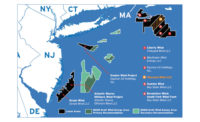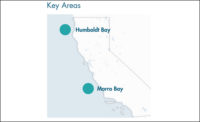Broader Offshore Wind Study Cites Fishing Lane Impacts

Expanded federal environmental review looked at 22 GW of planned East Coast wind farms.
GRAPHIC BY DYLAN SCHUTTER FOR ENR
A long-awaited broadened federal environmental review of overall effects of building 22 GW of offshore wind along the U.S. east coast over the next decade found mostly minor to moderate impacts, except in how placement of wind turbines and transmission cables could affect commercial fishing lanes.
Fishing trade groups sought the added offshore wind development analysis as part of the U.S. Interior Dept. final approval of the first large-scale U.S. wind farm, the 800-MW, $2.4 billion Vineyard Wind project proposed off the coast of Massachusetts. The agency required the cumulative impact study in a surprise move last year that has delayed project construction. Final approval now won’t come until year-end.
Interior’s supplemental environmental review, released June 11, considered construction of about 2,000 wind turbines over a 10-year period with currently available technology and also included use of larger turbines, which could reduce the number at Vineyard Wind to 57, from 100.
Analysis also added review of a proposal by a fishing trade coalition to add six four-mile-wide transit lanes for vessel traffic from southern New England ports to fishing areas on Georges Bank, in Canada. Only one lane would affect the Vineyard project, proposed 14 miles south of Martha’s Vineyard.
The agency found potential “major adverse impacts” without the proposed lanes. A U.S. Coast Guard study said the trade group’s call for larger transit lanes was not needed for safe navigation but the issue remains under further review by both.
A 45-day comment period now follows release of the Interior analysis. The agency expects to issue the last version of the broader study in November and a final decision on Vineyard the following month, said Walter Cruickshank, acting director of the department’s Bureau of Ocean Management.
“The offshore wind industry is committed to working closely with other ocean users and remains confident that the deployment of offshore wind is compatible with commercial fishing and safe navigation, as has been demonstrated for years in other countries,” American Wind Energy Association CEO Tom Kiernan said.
Vineyard Wind is 50% owned by Copenhagen Infrastructure Partners and 50% by Avangrid Renewables, a subsidiary of Iberdrola Group.




